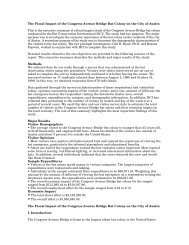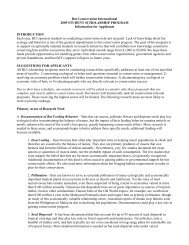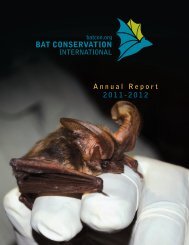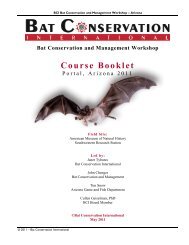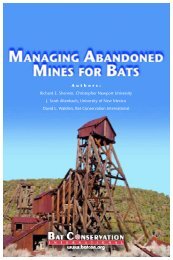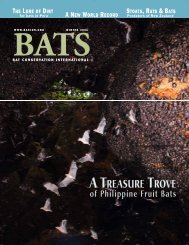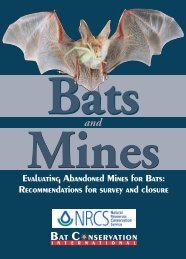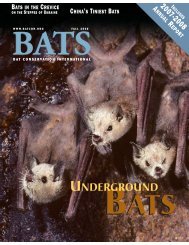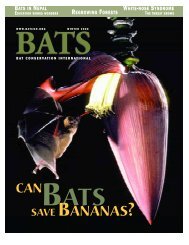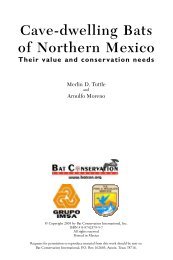Bat Echolocation Researc h - Bat Conservation International
Bat Echolocation Researc h - Bat Conservation International
Bat Echolocation Researc h - Bat Conservation International
Create successful ePaper yourself
Turn your PDF publications into a flip-book with our unique Google optimized e-Paper software.
intensity). Our ability to detect most bat species has not<br />
been measured accurately in the field because of the difficulties<br />
in doing so, although some attempts have been<br />
made (Forbes and Newhook 1990; Waters and Walsh<br />
1994). Recent developments in equipment to broadcast<br />
simulated echolocation calls of different species may<br />
enable experiments to measure detectability with more<br />
precision (G. McCracken, unpubl. data). Differential<br />
detection rates among species mean that comparisons of<br />
abundance cannot be reliably made among species and<br />
can only be made if data are weighted for differential<br />
detectability. While it is generally assumed that detection<br />
rates remain constant within a species, making possible<br />
an evaluation of changes in abundance, differential<br />
detection rates among habitats (open, edge, clutter) may<br />
confound such comparisons if the habitats sampled differ<br />
dramatically in structure (Parsons 1996; Patriquin et<br />
al. 2003). For example, if repeated monitoring of a location<br />
is carried out over time in which the area of cluttered<br />
woodland declines and becomes fragmented, sampling<br />
of the same sites may lead to the erroneous conclusion<br />
of an increasing population if detection of more<br />
bats forced into open/edge situations occurs. Knowledge<br />
about the potential magnitude of this bias is essential.<br />
Generally the assumption is made that the magnitude is<br />
small, since many species appear to show habitat preferences<br />
for either open or edge/cluttered habitats and their<br />
flight maneuverability may restrict them to these habitats<br />
(e.g. Nyctalus noctula, a fast-flying species with narrow<br />
wings, is rarely found in cluttered habitats). However,<br />
bats can exhibit surprising flexibility in their habitat<br />
use in different landscapes. Myotis emarginatus, a gleaning<br />
bat generally considered to hunt in dense tree<br />
crowns, was recently recorded hunting over open salt<br />
marshes in western France (H. Limpens, pers. comm.).<br />
DEFINING THE PURPOSE AND SCALE OF SURVEYS:<br />
STATE THE QUESTIONS/HYPOTHESES/AIMS<br />
An important factor to consider at the outset is the<br />
purpose and scale of the intended study. Appropriate<br />
methods for a particular study become more obvious if<br />
there is a clear goal, specified in advance. Most studies<br />
are tied directly to conservation-management needs and<br />
often have multiple but interrelated objectives. The most<br />
basic survey objectives include the need to detect the<br />
presence/absence of bats or the activity level of bats –<br />
also referred to as the index of abundance or relative<br />
abundance. Key sites and feeding areas may need to be<br />
located to provide information pertinent to local site<br />
management. Often, the objective of the survey is to<br />
provide data about specific species, and thus the need for<br />
species’ discrimination is introduced. Frequently, managers<br />
are required to inventory (list) the species present<br />
in an area, or to identify habitats used/not used by each<br />
species or by a species of special interest. A more<br />
demanding objective is to determine the relative activity<br />
Section 4: Resources, <strong>Researc</strong>h and Study<br />
or abundance of species and identify the most preferred<br />
or avoided habitats. Finally, the objective might be to<br />
monitor changes in distribution or relative abundance to<br />
ascertain patterns or trends over seasons or years.<br />
LOGISTICAL CONSTRAINTS<br />
Once the general objectives and scope of the survey<br />
have been defined, the next important step is to list the<br />
logistical constraints and adjust expectations where necessary.<br />
Often, logistical constraints will predetermine<br />
the end objectives and scope of the survey.<br />
Observers<br />
The number of skilled observers available to operate<br />
technical bat-detector equipment will constrain the<br />
number of sites which can be visited within a time window.<br />
A volunteer force of trained observers operating<br />
low-cost, easy-to-use equipment is one way that large<br />
numbers of sites spread across a large region can be surveyed<br />
(e.g., Limpens 1993; Walsh et al. 2001). However,<br />
this will introduce higher levels of observer variability.<br />
Examples where this approach might be used include:<br />
where the aim is to quantify the presence/absence or<br />
abundance of bats without a requirement for species<br />
identification; in regions where only a single species is<br />
present (e.g., Hawaiian hoary bat, Lasiurus cinereus); where<br />
more than one species is present, but they are easily distinguished<br />
(McCracken et al. 1997; O’Donnell 2000); or<br />
where one species has highly specific calls and can be<br />
distinguished with confidence from others (e.g., Euderma<br />
maculatum in western North America; Fenton et al. 1983).<br />
Equipment<br />
Whether or not more than one system is available,<br />
you can still choose to survey one or more than one site<br />
per night.<br />
Money and time<br />
Costs and the availability of funding and time will<br />
always be key limiting constraints.<br />
SELECTING FIELD TECHNIQUES<br />
<strong>Bat</strong> Detectors and Quantifying <strong>Bat</strong> Activity<br />
A range of bat detectors are available to conservation<br />
biologists and professional bat researchers at reasonably<br />
affordable cost. Although these are described in detail in<br />
other chapters of this volume, we briefly summarize<br />
them in relation to practical field use. The transformation<br />
of ultrasound into audible sound or visual depictions<br />
can be made with one of three main types of detector:<br />
heterodyne, frequency-division, and time-expansion.<br />
The choice of a bat-detector system depends upon the<br />
planned use for it and budget.<br />
Heterodyning and frequency-division are real-time<br />
methods, and thus observers can hear the sound from the<br />
159



